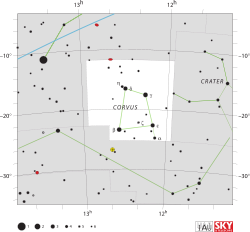軫宿三
| 觀測資料 曆元 J2000.0 | |
|---|---|
| 星座 | 烏鴉座 |
| 星官 | 軫 (星官) |
| 赤經 | 12h 29m 52s |
| 赤緯 | -16° 30′ 55.5″ |
| 視星等(V) | +2.96 |
| 特性 | |
| 光譜分類 | A0V |
| U−B 色指數 | -0.05 |
| B−V 色指數 | -0.05 |
| 天體測定 | |
| 徑向速度 (Rv) | +9 km/s |
| 自行 (μ) | 赤經:−210.49 mas/yr 赤緯:−138.74 mas/yr |
| 視差 (π) | 37.55 ± 0.16 mas |
| 距離 | 86.9 ± 0.4 ly (26.6 ± 0.1 pc) |
| 絕對星等 (MV) | +0.83 |
| 詳細資料 | |
| 質量 | 2.5 [1] M☉ |
| 亮度 | 60 L☉ |
| 溫度 | 10400 K |
| 自轉速度 (v sin i) | 236 km/s |
| 年齡 | 260+14 −24×106 or 3.2+0.1 −0.1×106 年 |
| 其他命名 | |
| 參考資料庫 | |
| SIMBAD | 資料 |
恆星特性[編輯]
軫宿三有2.5倍太陽質量,造成它的光度比太陽高的多,約是60倍太陽光度。表面溫度10,400K,散發出白色的光芒。[4]它的恆星分類為A0V-IV[5],但是它的光度比主序星還要高一些。因此它可能是個年齡2.6億的次巨星,已經快要耗盡核心的氫並且正在演化離主序帶,或是320萬年的前主序星,還沒有完全凝聚並且在主序帶上穩定下來。[6]
1823年,英國天文學家James South和約翰·赫歇爾發現軫宿三是一個雙星。從那時起,兩星的相對位置都沒有改變。[7]9.3等的伴星,HR 4757 B,恆星分類K2Ve,角距離24.2弧秒,位置角214°。[7][8]雖然兩星有相同的自行,年齡的明顯差距代表它們可能不是有物理關聯的。[6]
2006年的研究發現軫宿三沒有代表星周物質存在紅外線超量,[9]但是更熱的星際塵埃在2014年的一個研究被檢測到。[10]
參考[編輯]
- ^ Kaler, James B. ALGORAB (Delta Corvi). Stars. University of Illinois. [2010-02-24]. (原始內容存檔於2020-07-28).
- ^ IAU Catalog of Star Names. [28 July 2016]. (原始內容存檔於2018-07-07).
- ^ van Leeuwen, F., Validation of the new Hipparcos reduction, Astronomy and Astrophysics, November 2007, 474 (2): 653–664, Bibcode:2007A&A...474..653V, arXiv:0708.1752
 , doi:10.1051/0004-6361:20078357
, doi:10.1051/0004-6361:20078357
- ^ The Colour of Stars, Australia Telescope, Outreach and Education (Commonwealth Scientific and Industrial Research Organisation), December 21, 2004 [2012-01-16], (原始內容存檔於2012-03-10)
- ^ Gray, R. O.; et al, Contributions to the Nearby Stars (NStars) Project: Spectroscopy of Stars Earlier than M0 within 40 parsecs: The Northern Sample I, The Astronomical Journal, July 2006, 132 (1): 161–170, Bibcode:2006AJ....132..161G, arXiv:astro-ph/0603770
 , doi:10.1086/504637
, doi:10.1086/504637
- ^ 6.0 6.1 Montesinos, B.; et al, Parameters of Herbig Ae/Be and Vega-type stars, Astronomy and Astrophysics, March 2009, 495 (3): 901–917, Bibcode:2009A&A...495..901M, arXiv:0811.3557
 , doi:10.1051/0004-6361:200810623
, doi:10.1051/0004-6361:200810623
- ^ 7.0 7.1 Garfinkle, Robert A., Star-Hopping: Your Visa to Viewing the Universe, Cambridge University Press: 109, 1997, ISBN 0-521-59889-3
- ^ Eggleton, P. P.; Tokovinin, A. A., A catalogue of multiplicity among bright stellar systems, Monthly Notices of the Royal Astronomical Society, September 2008, 389 (2): 869–879, Bibcode:2008MNRAS.389..869E, arXiv:0806.2878
 , doi:10.1111/j.1365-2966.2008.13596.x
, doi:10.1111/j.1365-2966.2008.13596.x
- ^ Su, K. Y. L.; et al, Debris Disk Evolution around A Stars, The Astrophysical Journal, December 2006, 653 (1): 675–689, Bibcode:2006ApJ...653..675S, arXiv:astro-ph/0608563
 , doi:10.1086/508649
, doi:10.1086/508649
- ^ Ertel, S.; Absil, O.; Defrère, D.; Le Bouquin, J.-B.; Augereau, J.-C.; Marion, L.; Blind, N.; Bonsor, A.; Bryden, G.; Lebreton, J.; Milli, J. A near-infrared interferometric survey of debris-disk stars. IV. An unbiased sample of 92 southern stars observed in H band with VLTI/PIONIER. Astronomy & Astrophysics. 2014, 570: 20. Bibcode:2014A&A...570A.128E. arXiv:1409.6143
 . doi:10.1051/0004-6361/201424438. A128.
. doi:10.1051/0004-6361/201424438. A128.
| ||||||||||||||||||||||
| ||||||||||||

